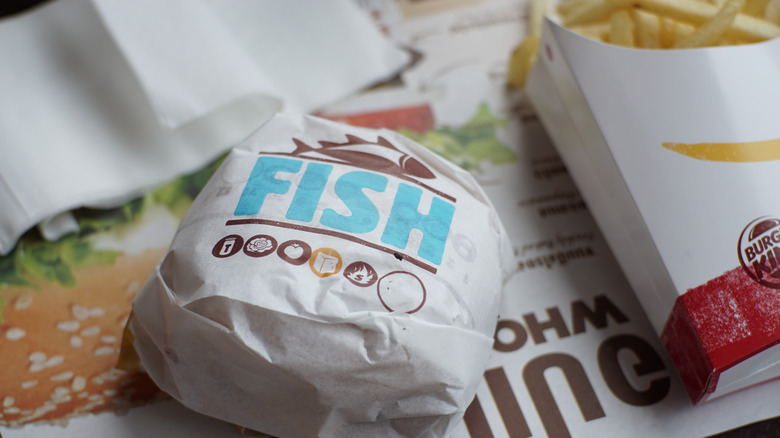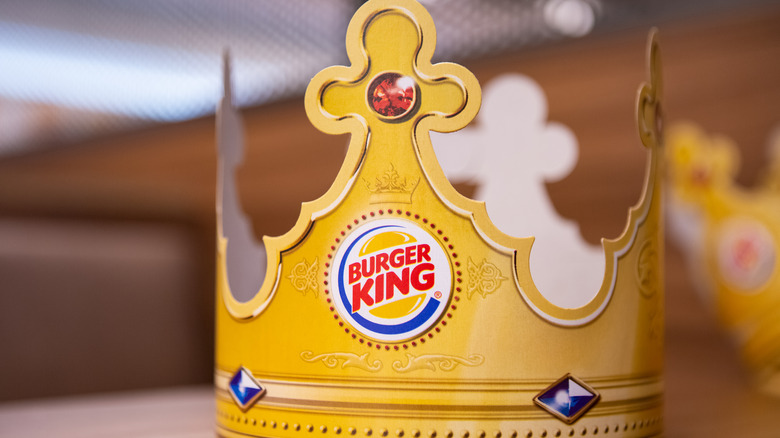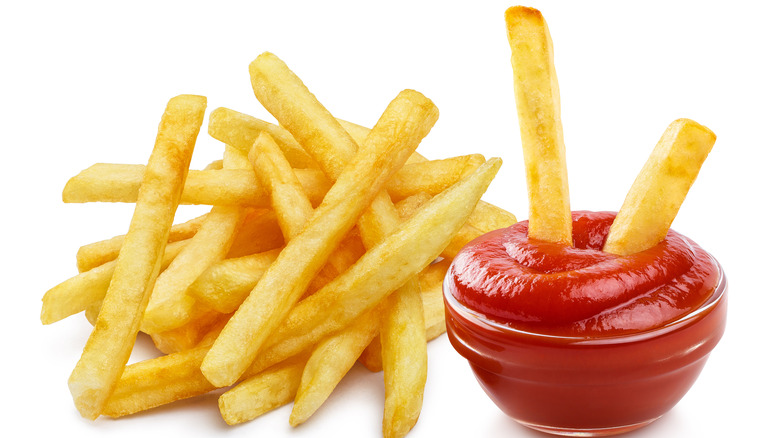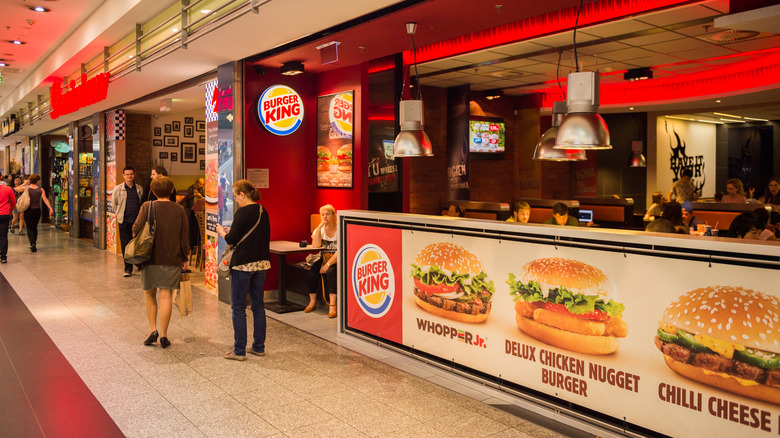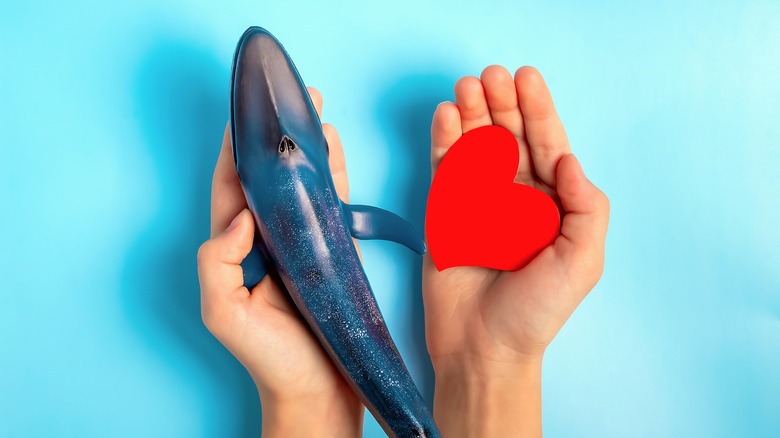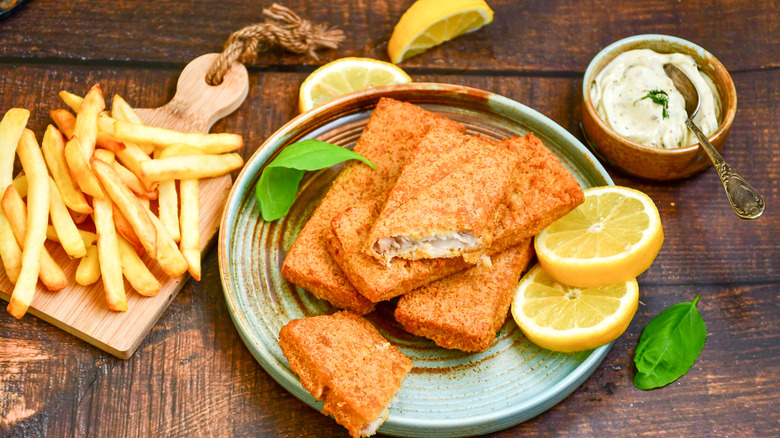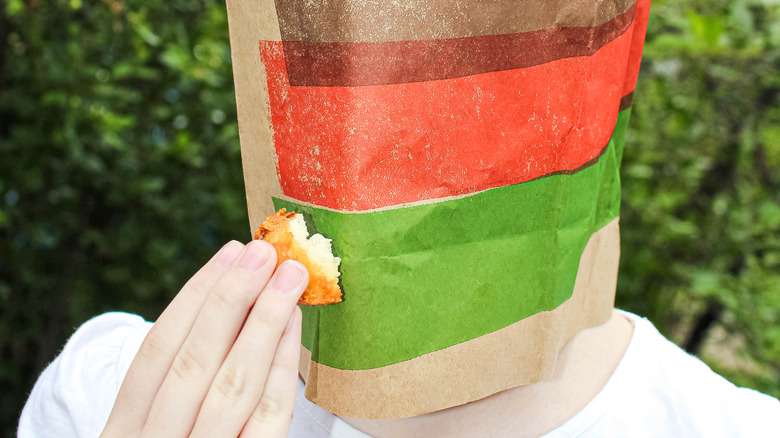The Truth About Burger King's Big Fish Sandwich
Decades before the word "Insta" was associated with a photo-sharing app, the second-largest burger joint in the world, Burger King, was getting its start. Originally founded by Keith Kramer and Matthew Burns in Jacksonville, Florida, this fast food restaurant — initially named Insta-Burger King — opened its doors in 1953 serving an array of broiled burgers, milkshakes, and fries. According to Business Insider, David Edgerton and James McLamore took over the reins just a year after the company's founding and expanded it to 274 branches across the U.S. It was eventually acquired by Pillsbury Company in 1967.
The Whopper came onto the scene in 1957 and remains a signature of the company. The fish sandwich started showing up in Burger King restaurants in the mid-60s and became a national item about a decade later (via Retroist). Then called the Whaler, it was dubbed "The genuine Burger King fish-steak sandwich." Today, Burger King is a household name where fast food restaurants are concerned, and through controversies and boycotts, recalls and comebacks, and questionable bills of health, the fish sandwich has undergone several changes over the years since its creation. Reel on to get schooled on the history of Burger King's Big Fish.
Fast food fish sandwiches were created because of Lent
Every year, millions of Catholics around the world observe Lent; a 40-day period during which they are expected to not eat meat on Fridays. What does this have to do with Burger King and the Big Fish? The story actually starts with McDonald's, and a franchise owner Lou Groen. Based in Cincinnati, Groen served a 90% Catholic customer base, and Friday sales plummeted during February and March when the customers observed Lent. While his business suffered, a neighboring Big Boy restaurant did well with its fish sandwich (via Thrillist).
Seeing an opportunity, Groen created the Filet-O-Fish in 1962, approached the franchise headquarters, and went head-to-head with founder Ray Kroc's Hula Burger (a meatless combo of a grilled pineapple slice and cheese on a bun) to see which would make the most sales one Friday. Needless to say, the Filet-O-Fish won and became a permanent national menu item by 1965.
It's no surprise that McDonald's competitor Burger King noted the Filet-O-Fish and responded with the launch of the Whaler a few years later (via Portable Press).
A Big Fish squabble earned one burger king employee $46K
In 2014, Usha Ram was fired from a Burger King in Vancouver, Canada for supposedly stealing a fish sandwich. It all started on Boxing Day in 2013 when Ram asked restaurant manager, Tayyaba Salman if she could take some food home. While Ram cited having forgotten her wallet when she asked for the food, it seems the store's policy also allowed employees to have free beverages during their shifts, to receive a 50% discount on food, and for the manager to make exceptions at their own discretion (via BBC News).
Salman reported Ram to one of the owners, Janif Mohammed, for taking a fish sandwich, fries, and beverage. Ram offered to pay for the value of the food (which amounted to 50¢ after the employee discount), which was deemed an admission of guilt by Mohammed. She was fired without severance in January 2014, having worked with Mohammed since 1989. Citing that the matter had been handled in an "unreasonable, unfair and unduly insensitive manner," Justice Lisa Warren ordered co-owners, Janif Mohammed and Michael Lacombe, to pay Ram $21,000 and $25,000 in general and aggravated damages, respectively. At the time, Usha Ram was the only member of her family earning an income while caring for her husband and daughter.
It features on a dedicated Burger King Lent menu in Lebanon
Most fast-food restaurants have an item or two that is made with fish that Catholics can eat during Lent. However, you don't usually see a whole menu set up specifically for observers of Lent, at least in the U.S. In Lebanon, Burger King goes above and beyond during the fasting season.
The Burger King Lent Selection offers an array of meat-free menu items, and the Big Fish patty is featured as the base for several of them. Beyond the Big Fish is a Big Fish Deluxe (with added onions, pickles, Big King sauce, and a slice of cheese), Big Fish and Big Fish Deluxe Meals, and a Big Fish Deal. The Big Fish Deal is a Big Fish Meal with an extra Big Fish sandwich. Other offerings include the H-Loumi King, made with a halloumi patty, and the Batata Burger, which is a french fry sandwich topped with, pickles, lettuce, mayo, and ketchup. Fish sales in American restaurants are known to increase by approximately 20% during Lent, but with a Lent Selection like this, you're not obliged to satisfy your Lenten fast-food cravings with fish.
It's been renamed multiple times since it first launched
Unlike the Filet-O-Fish, which has remained basically the same in both composition and name since it was introduced in the '60s (aside from a disastrous attempt to make Filet-O-Fish nuggets), Burger King's fish sandwich has gone through many changes in identity over the decades. As Retroist writes, the fish sandwich became the Ocean Catch Fish Filet in 1990. It's also been known as the Long Fish sandwich, the Premium Alaskan Fish Sandwich, and its current moniker, the Big Fish. We also can't forget the Extra Long Fish Sandwich, which was released in 2016 (via Fast Food Geek).
One attribute that many of the names share is an obsession with size. The name "Whaler" evokes a gargantuan sandwich, and the 1983 commercial for The Return of the Whaler notes that Burger King's fish offering is larger than the McDonald's equivalent. If there's one thing Burger King wants you to know, it's that its fish sandwich will fill you up.
The Big Fish bun has changed as often as its name
It seems with every new name and supposedly reformulated fish sandwich, the changes were often relegated to the bun. Perhaps there's only so much you can do before a fish sandwich loses the signature simplicity most patrons love.
With prior changes having included reformulating the chicken sandwich the whaler and giving the Cajun Whaler a spicy fish patty, the Whaler became the Ocean Catch and came with a different bun. The Extra Long Fish Sandwich used the same ingredients but for a toasted hoagie bun and rectangular fish patty rather than the customary square patty associated with fish sandwiches, while the Premium Alaskan Fish Sandwich sat on a bakery-style bun. When it was eventually reformulated as the Big Fish, Burger King emphasized that the sandwich is made with "100% White Alaskan Pollock" and "breaded with crispy panko breading." But in keeping with a longstanding pattern, the bun changed to a brioche-style bun.
Burger King was once boycotted for the big fish's ties to whaling
Perhaps a dark case of foreshadowing, more than a decade after its initial launch, the Whaler landed Burger King in some not-so-cool waters between 1988 and 1989. According to the South Florida SunSentinel, approximately 40 members of the independent environmental campaigning organization Greenpeace gathered outside a Burger King in Fort Lauderdale. In downtown Los Angeles, another 50 members also gathered outside Burger with signs declaring "Save the Whales" (via Los Angeles Times). These were both part of a nationwide effort to protest Burger King's purchase of fish from Iceland. At the time, the International Whaling Commission had issued a moratorium to pause commercial whaling, as the animals were endangered.
The call to boycott Burger King wasn't necessarily about Burger King or about the Whaler (an unfortunate name considering it doesn't contain whale meat). Rather, as one protest organizer, Lynn Howard, asserted; Burger King sourced its cod from Iceland, which had made approximately $400 million in 1986 from exporting fish to the U.S. Protesters claimed that even though Iceland was legally permitted to conduct scientific research, these rights were exploited to continue commercial whaling. The protestors hoped that convincing a company like Burger King to source its cod from other countries could influence Iceland to rethink its whaling practices. By August 1988, Burger King had reduced its supply of Icelandic fish by 20%, but according to Pillsbury Company spokesperson Tim Hermeling, the reason for this was "confidential."
The healthiest part of the sandwich is the white Alaskan pollock
Although every new version of the Big Fish has contained slight variations in the ingredients, one that's remained fairly consistent throughout several reformulations is the White Alaskan Pollock breaded patty. The fish of choice in everyday frozen fish products such as fish fingers and sticks, pollock boasts an impressive nutrient profile. A 100 gram serving of pollock has 23.5 grams of protein — this is about half of the daily recommended value for the average sedentary adult.
According to Organic Facts, pollock offers a significant amount of omega-3 fats, which are great for your heart. These, in addition to a range of other nutrients (including vitamin B12, calcium, and selenium, amongst others), aid in skin and hair health, reduced risk of cancer, and lower levels of cholesterol. Other benefits include increased cognitive health and metabolic processes which might aid reproductive health. Of course, these benefits remain dependent on one's overall diet quality. Another important benefit to note is the level of mercury found in pollock. This and other toxins are often a concern when it comes to the consumption of fish, however Alaska Pollock has low mercury levels.
But the sodium content is exceptionally high
It's probably safe to assume that nobody goes to fast-food restaurants looking for a healthy meal, but a nutritionist at CNN Health still singled out the Big Fish sandwich as a great Burger King menu item to enjoy on a road trip — sans the tartar sauce and about half of the bun. More concerning than the calories in the breaded mixture around the Burger Fish patty or the bun though, is the high sodium found in the sandwich as a whole.
According to the nutrition facts on Burger King's website, a Big Fish sandwich contains 1,275 milligrams of sodium. The Food & Drug Administration recommends a daily sodium intake of less than 2,300 milligrams a day. As such, this sandwich accounts for over half a day's worth of sodium, and that's before you take french fries into account. High sodium content in food has been associated with increased risks of high blood pressure — which is linked to strokes, cardiovascular and chronic kidney disease, osteoporosis, and stomach cancer (via Harvard T.H. Chan School of Public Health).
Burger King employees probably don't eat it
We all appreciate that when we get to a fast-food restaurant and place an elaborate order with meal combos, extras, and sweet treats, it's all ready within a matter of minutes. Even if you're a culinary whiz, a homemade replica of said meals would never be ready that quickly. Of course, fast doesn't always mean good, and there are some fast food items you should never order if employees are to be believed.
Fish is a delicate food that doesn't respond well to being mistreated. The fish in a Big Fish sandwich comes with some warnings from Burger King employees who would strongly suggest you avoid it. One Reddit user is very specific: "The fish sandwich. It's rectangular fried fish and breading. Absolutely disgusting. They also keep some surplus so they don't have to make it new each time someone orders it, so you may be getting old fish." Another says, "yeah, I worked at a BK for a few days in college and the fish was the worst offender. we had the same 2 or 3 fish filets in the warmer for entire days sometimes." But if you must have it, user Giulls advises that you should "ask specifically for fresh (kitchen knows you asked for fresh in your order so it should be fresh)," provided you're willing to have your fast food not-so-fast.
Consumers demanded a spicy big fish and got it
When Burger King released the Cajun Whaler as a limited offer in 1987, it turned out that those who didn't take advantage of it would have to wait over 20 years before it introduced another spicy fish sandwich to its menu. The return of a spicy option might be thanks to millenials, who according to McCormick Company's 2015 Flavor Forecast, prefer spicy flavors. Mars Foodservices went on to report that across generations, millennials have the biggest influence on flavor trends.
With spicy foods becoming trendy, Burger King went ahead and launched the Spicy Big Fish sandwich in February 2015. Not deviating too much from the original Big Fish, the Spicy Big Fish simply swapped out the tartar sauce for a creamy spicy sauce. At the time of the launch, Burger King's Chief Marketing Officer, Eric Hirschhorn made clear that this was about honoring consumers' demands, saying, "We listen to our guests and want to continually provide them with new seasonal options. Now they can choose between the original Big Fish Sandwich or opt to turn up the heat with our new Spicy Big Fish Sandwich — a real catch for fish fans" (via Businesswire).
